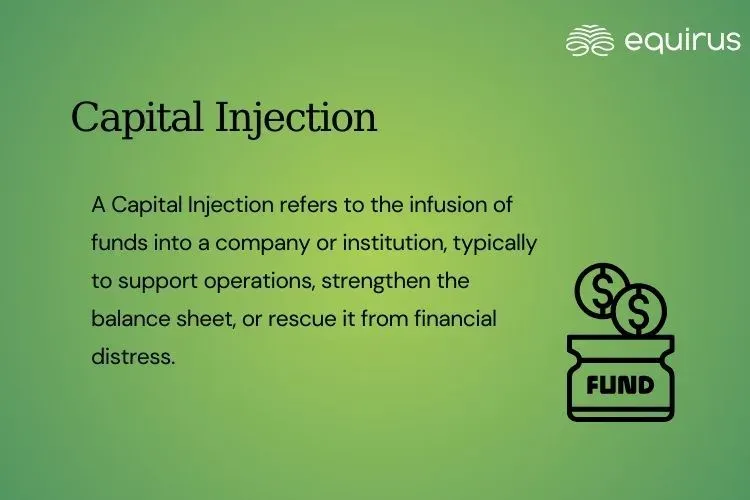Capital Injection

Key Highlights
-
A Capital Injection refers to the infusion of funds into a company or institution, typically to support operations, strengthen the balance sheet, or rescue it from financial distress.
-
Forms of capital injection includes equity capital, debt capital, government bailouts or grants and intercompany funding.
What is Capital Injection?
A Capital Injection refers to the infusion of funds into a company or institution, typically to support operations, strengthen the balance sheet, or rescue it from financial distress. This can come from investors, governments, banks, or parent companies and may take the form of equity, debt, or grants.
Why it Happens?
Capital injections are made when a company:
-
Is facing a cash crunch
-
Needs to meet regulatory capital requirements
-
Wants to expand or scale operations
-
Has suffered unexpected losses or downturns
-
Is strategically restructuring
Forms of Capital Injection
1. Equity Capital
- Funds raised by issuing new shares to investors.
- Increases ownership base but dilutes existing shareholders.
2. Debt Capital
- Funds injected via loans or bonds.
- Does not dilute equity but adds repayment obligations.
3. Government Bailouts or Grants
- Non-market-based capital often used in crises (e.g., banking or airline sector support).
4. Intercompany Funding
- Parent company provides capital to its subsidiary.
Example
A startup receives a ₹5 crore capital injection from its existing investors to extend its runway by 12 months.
A public sector bank in India receives a capital injection from the Government of India to improve its capital adequacy ratio.
Capital Injection vs. Investment
-
Capital Injection is often associated with financial recovery or reinforcement.
-
Investment typically implies voluntary capital deployment for growth or profit.
-
Capital injection is sometimes reactive (to save or stabilize) while investments are proactive (to grow or expand).
Benefits
-
Improves liquidity and solvency
-
Builds investor confidence
-
Helps meet regulatory capital norms
-
Prevents business shutdown or loss of jobs
Risks or Drawbacks
-
Can dilute ownership (in case of equity)
-
May lead to increased debt burden
-
May give an impression of financial weakness
-
Government injections may come with restrictions or conditions
Capital Injection in the Indian Context
-
The Government of India has periodically infused capital into public sector banks to meet Basel III norms and improve lending capacity.
-
Startups often raise bridge rounds as capital injections to survive between funding cycles.
-
During COVID-19, emergency capital injections supported companies in aviation, tourism, and healthcare.
